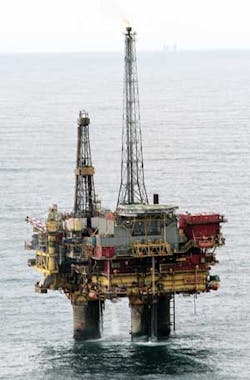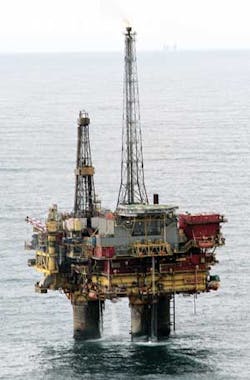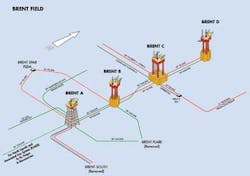Shell grapples with uncertainties of Brent field decommissioning
Shell is preparing to decommission the Brent field production complex in the UK northern North Sea. The company expects to issue an environmental impact assessment this year, followed by a final decommissioning program in 2013. Assuming government sanction, all four of the Brent field's giant platforms will be shut down and dismantled over the next few years, under what is expected to be one of the most technologically demanding abandonment projects ever attempted.
Brent was one of the UK's earliest and largest oil and gas development projects, with all the platforms coming onstream in 1975-76. During the 1990s, Shell initiated a £1.3-billion ($2-billion) re-development that involved re-configuring the Brent B, C, and D installations for lower-pressure production, in order to extend the field's life (the target at that time was 2008). Over the past three decades, Brent has delivered over 2 Bbbl of oil and 6 tcf of gas, but output is declining to a point that will eventually render it unviable.
Shell has sold off other tail-end UK North Sea fields to independent operators, but the company sees little residual value in Brent's case. It has considered re-use possibilities for the platforms, ranging from offshore prisons and casinos to wave power and wind farms. But the company has concluded that none were viable due to the age of the facilities, distance from shore (180 km/115 mi), and prohibitive reinvestment and operating costs.
Shell is cooperating with The UK's Department of Energy and Climate Change (DECC) on its "End of Field Life" planning process. The two parties have agreed on the earliest possible dates for ending production through the facilities, although the actual dates will be governed by various operational and market factors. On Brent Delta, a program is under way to abandon the redundant wells before production ceases, and Shell is progressing the tender process for contracts to decommission the platform.
Platform dimensions
The Brent complex is 145 km (91 mi) northeast of Unst, Shetland, in 141 m (462 ft) of water. Brent Alpha is a conventional fixed installation, comprising a 14,225-metric ton [15,680-ton] jacket with six tubular steel legs secured to the seabed via piles, and supporting a 16,605-mt (18,309-t) topsides.
Brent Bravo and Delta are "Condeep," three-leg concrete gravity-base structures (GBSs). In both cases, the base comprises 19 reinforced concrete cells arranged in a hexagonal-shaped honeycomb caisson, secured to the seabed by 4-5 m (13 to 16.4-ft) steel skirts. Three of the cells extend upward to form the leg bases, while the other 16 are capped off below sea level, and are used for crude oil storage in Brent D's case and for crude/ballast water storage on Brent B.
The storage cells range in height from 60 m (197 ft) on Brent D to 56 m (184 ft) on Brent B, and the three supporting legs are around 165 m (541 ft) high. In both cases, the total area of the substructure base is 6,360 sq m (68,458 sq ft) and the dry weight in air is 318,850 mt (351,472 t), including ballast. Above the waterline, Brent D has a cellular lower deck formed from interconnecting steel girders. This supports a 23,500-mt (25,904-t) topsides comprising a module deck and drilling deck. There is a similar configuration on Brent B, but the topsides are heavier, at 24,095 mt (26,560 t).
Brent Charlie is a Sea Tank-type concrete gravity base installation with a 57-m (187-ft) tall caisson substructure featuring 32 cells for oil and diesel storage and oil export, all operating in a completely flooded condition. Four concrete legs extend upwards from the floor of the caisson to 149 m (49 ft) above the seabed. These support four steel transition pieces, each 15.7 m (51.5 ft) high, which in turn support a superstructure comprising cellar deck, module deck and drilling deck modules. The total substructure area is 10,340 sq m (11,300 sq ft) and the dry weight 290,516 mt (320,239 t).
All four platforms have facilities for drilling and production of oil and gas, with the oil exported via the Brent pipeline system to Sullom Voe, Shetland, and the gas to St Fergus, north of Aberdeen, via the FLAGS system. Each platform has equipment for metering, pumping, storage and maintaining formation pressure, mainly via water/gas injection. Brent C also hosts production from Shell's subsea Penguins development, and is the main pump station platform for the Brent/Cormorant pipeline, commingling oil from numerous third-party fields in the area. Brent B is the main gas compression platform for the Brent gas export pipeline to St Fergus, northeast Scotland.
The installations are connected via infield pipelines. Since the platforms are due to be decommissioned in phases, a reconfiguration of the pipeline network may be needed to maintain Brent's export routes until final cessation of production.
Disposal issues
Shell appointed Wood Group PSN to review and maintain the installations' structural integrity in order to minimize the risks during the removal process. Their sheer size and condition present severe difficulties, said Austin Hands, Brent Field Decommissioning Project Director. Hands, who took on his role over three years ago, admitted that the scope and scale of the program was daunting: "When the three large GBSs were designed and put in during the 1970s," he pointed out, "little thought was directed at how to get them out."
As for the Brent topsides, Shell has opted to remove them to shore for disposal, with a target of 94% recycling. But as Hands pointed out, "that's a combined weight of 100,000 tons to lift out, and if we do it by a reverse installation method, that means hundreds of days using existing heavy-lift vessels." These may be difficult to secure, he pointed out, with other big North Sea extractions in prospect such as CNR's Murchison platform. "There is definitely potential in the market for a new single-lift vessel able to manage 40,000 t in one lift," he added.
Preparations and execution will take two years for each of the four platforms, Hands said, involving "a considerable spend." In addition, there are 24 separate pipelines to remove, and 130 wells to shut down. When he first arrived, Hands recalled, the wells team assured him that this would be routine. "In fact," he said, "our investigations suggested that each well will take on average 30 days to decommission, taking into account tubular failures and corrosion." In one case, shutdown took 50 days because the formation had collapsed.
Shell continues to seek solutions for the more difficult wells, and by September had invested £1 million ($1.54 million) in developing innovations such as new barrier materials for plugging cement back. "We're sharing these lesson learned with the industry," Hands noted. Shell in turn is drawing on experiences from other large-scale removal projects in the North Sea involving facilities on the Frigg, Northwest Hutton, and Ekofisk fields. In the latter case, ConocoPhillips encountered severe difficulties when trying to take out the giant Ekofisk concrete seafloor storage tank.
"Right now we're in the define phase and we've gone for a concept selection, what we think are the right solutions," Hands elaborated. "Various FEED exercises have been paid for, which have benefited the heavy-lift specialists in terms of understanding the challenges. We have also completed studies for the refloat of the concrete structures, which is likely to be difficult. If you put in energy at the seabed, there is a risk that they would come up like a cork and disintegrate."
According to OSPAR Decision 98/3, topsides facilities of all redundant offshore platforms must be returned to shore for re-use, recycling, or disposal. This also applies to all installations with a steel jacket substructure weighing 10,000 mt (11,023 t) or less. However, the OSPAR decision recognizes that there may be technical difficulties and major environmental/safety risks in removing some support structures, and therefore some exceptions may be granted, known as "derogations."
These will be considered for concrete gravity base structures and footings of steel jackets weighing over 10,000 mt (11,023 t). "Footings" applies to those parts of the steel structure below the highest point of the piles fixing the jacket to the seabed. BP is thought to have been successful in its bid for derogation for the Miller platform in the central North Sea.
Shell has identified all four Brent platforms as candidates for derogation, and according to UK field analysts BritBoss, the company plans to submit a derogation document early next year followed by submission of a final decommissioning program in summer 2013. UK rules, however, permit cessation of production prior to obtaining approval for decommissioning, and this is what Shell plans to do later this year on Brent D under a process it calls "engineering down," involving safe shutdown of the platform's facilities, hydrocarbon cleaning and disconnections, and preparation of the topsides for removal. Depending on subsequent events – i.e., the timescale for approval by the UK Department of Energy and Climate Change – full-scale decommissioning of Brent D could start next year, followed by Brent A and B, and finishing perhaps in 2016 with Brent C.
Cell investigations
One of the major concerns on the three GBS platforms is the condition of the storage cells. As Hands pointed out, "no one has been inside these cells since they were made in Norway [during the 1970s]. We have to drill a hole in the top, understand the contents, and either remove them or possibly reinject them into a well." But this is a costly procedure, which could cost £35 million ($454 million).
According to Shell's latest update, the company plans to mobilize a survey team, working with Subsea 7 among others, to enter the cells in the Brent D base using ROV-deployed equipment specially developed and tested for this project to recover samples from the assumed sediment.
Brent Decommissioning Project Execution Manager John Gillies said the company presented two concept scenarios for the contents of the cells during stakeholder dialogue sessions in summer 2010. These focused on "remove and treat" and "leave sediments in place." But what was missing were actual samples, because the cells could not be entered during their 30-year operating life-span.
The equipment for the investigative program is designed to drill through the top of the reinforced concrete structures, which are over 1 m (3.3 ft) thick, then lower surveying and sampling tools into the cells. Shell planned two offshore campaigns – under the first phase, divers would install at the top of the selected cell the base plate, valve and seal assembly for the ROV-operated drilling stack. During the second phase, involving drilling and sampling, a sonar tool would map the surface contours of the sediment layer, followed by deployment of other specialized tools to assess the condition of the sediment before retrieving samples to the support vessel. These would then be sent to shore for laboratory analysis.
Offshore Articles Archives
View Oil and Gas Articles on PennEnergy.com
About the Author
Jeremy Beckman
Editor, Europe
Jeremy Beckman has been Editor Europe, Offshore since 1992. Prior to joining Offshore he was a freelance journalist for eight years, working for a variety of electronics, computing and scientific journals in the UK. He regularly writes news columns on trends and events both in the NW Europe offshore region and globally. He also writes features on developments and technology in exploration and production.



